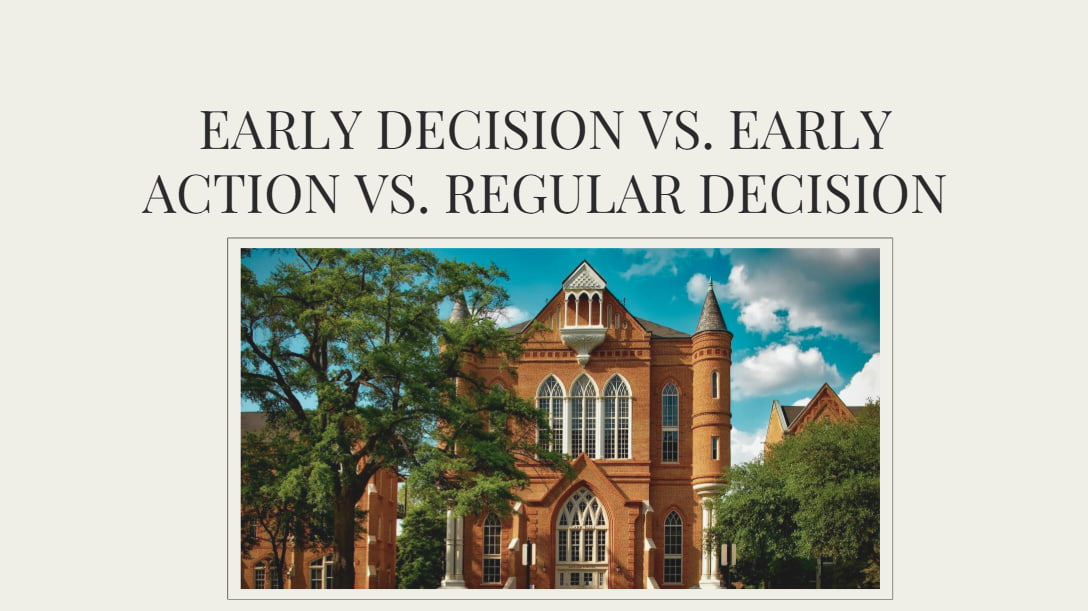Over the past ten years as a college admissions advisor, I’ve seen hundreds of students struggle with one big question every fall: Should I apply Early Decision, Early Action, or Regular Decision? That’s a good question, and the answer could affect your whole senior year.
I’ll explain the pros and cons of Early Decision vs. Early Action vs. Regular Decision in this piece so you can choose the road that best fits your goals, schedule, and level of comfort.
What Is Early Action vs. Regular Decision?
When you apply to a college early (usually by early November), you get a response by December or January. This is called Early Action (EA). The main benefit? Even if you’re accepted, you don’t have to promise right away because it’s not binding. To make your final Decision, you still have until May 1.
Regular Decision (RD), on the other hand, is the standard time frame for admissions. Most of the time, applications are due in early January, and decisions are made in the spring, usually in March or April. This route gives you more time to improve your essays, raise your GPA with grades from the fall semester, or retake standardized tests if you need to. You’ll have to wait longer to hear back, though, and there will be more students applying than ever before.
You might be wondering why this choice is important now. The mood of your final year can change depending on this decision, in my experience. Students who take Early Action typically feel like they have more drive and direction early on.
By the way, getting things done by winter gives you a chance to relax while others are still working hard on their applications.
To simplify matters, I’ve prepared a side-by-side comparison.
| Category | Early Action | Regular Decision |
| Application Deadline | Early November | Early January |
| Binding? | No – you’re not obligated to attend if accepted | No – full flexibility remains |
| Decision Released | December or January | March or April |
| Time to Decide | Until May 1 | Until May 1 |
| Number of Schools | Can apply to multiple (unless Restricted EA) | As many as you want |
From what I’ve seen, the best fit depends on your specific needs. Some students do better when they have more time because they are ready and want to finish. Others like the extra time that RD gives them, especially if they are still working on their academic background or choosing between schools.

What Are the Benefits of Early Action vs. Regular Decision?
One of the best things about early action is that it gives you more time. If you apply for EA in November, you should hear back by December or January. Getting in early can really help you feel less stressed, especially if you get into one of your top picks. You’ll also have more time to look at different financial aid packages and go back to school before May 1.
RD, on the other side, gives you a few more months, which is great if you’re still working on your grades, retaking the SAT or ACT, or polishing your essays. The downside is that you won’t see results until much later, usually in March or April.
Let’s break it down in a simple table.
| Factor | Early Action | Regular Decision |
| Commitment Required | No, you have full flexibility | No — you have full flexibility |
| Time to Prepare Application | Less. The application is due early fall | More. Extra time for revisions, retests, and stronger grades |
| Stress Level | Lower in spring. Earlier decisions reduce waiting anxiety | Higher. Results come late, sometimes all at once |
| Strategic Advantage | No, you can wait and compare offers | No demonstrated interest benefit, larger and more competitive pool |
Remember, the ideal option depends on when you apply, how ready you are academically, and how sure you are that you will get accepted before the fall.
What Does Early Decision Mean?
Let’s talk about one of the biggest commitments in the college admissions process: Early Decision (ED).
When you apply Early Decision or Early Action, you must understand the difference. These options often confuse students, but here’s the main part: Early Decision plans are binding. That means if you’re accepted, the Decision is a binding commitment—you’ll attend that school, no matter what.
Most students apply early to one school through ED in early November and get results earlier than regular Decision, usually by mid-December. So if you get in, you’re done. No comparing offers, no changing your mind.
From my experience, you should only consider applying early through ED if you’re 100% sure about the school, both emotionally and financially. This is not a time for “maybe.” If you’re making an early decision to a college, your early decision commitment should be based on solid research, not rankings or pressure.
Also, don’t forget about cost. You’re committing before seeing financial aid packages from other schools. And while some Early Decision options allow you to back out for financial reasons, it can be stressful.
So if you’re applying early action or regular, just know ED is about being ready to say “yes” without hesitation.
Early Action vs. Early Decision vs. Regular Decision
Let’s think more about how these three choices stack up in terms of time, flexibility, and costs.
Timeline and Deadlines
Below is a quick look at the usual timeline and deadlines for the college application process.
| Application Plan | Deadline | Decision Notification |
|---|---|---|
| Early Action | Nov 1–15 | Mid-December |
| Early Decision I | Nov 1–15 | Mid-December |
| Early Decision II | Jan 1–15 | February |
| Regular Decision | Jan 1–15 | March or April |
It’s also important to note that many colleges offer both Early Decision I and Early Decision II. The big difference? ED II gives you more time to improve your application. It’s a great option if you weren’t ready for ED I or didn’t get in elsewhere through early action or regular ED.
So, if you’re someone who likes to plan, applying Early Action vs. Regular Decision is a great option. RD might be a better choice, though, if you need a little more time to improve your application or want the freedom to look at more than one college or university.
Also, choosing between restrictive early action and early Decision depends on how ready you are to commit. Early decision applicants apply to one college, while those who apply for early action can still apply to colleges later. Some schools offer both early options, but policies vary.
Look into each school’s early decision plans and consider whether applying early fits your timeline. These options can lead to an admission decision earlier than a regular application, giving you more time to make your final Decision once you receive a decision from your chosen college or university.
Flexibility and Freedom
How you apply—early application or regular decision application—really changes how much control you have.
Early admission gives you faster results without locking you in. You can apply to several schools, get your response sooner, and compare aid packages before making your final call.
If you apply Regular Decision, you’ve got more time to work on your application and decide what feels right. Most use the Common Application and apply in January.
Below is a quick breakdown:
- Early application = Earlier results, less pressure to commit.
- Regular Decision = More time to prepare, broader options.
- Early Decision = Binding, one-shot offer to one college.
Just remember, an Early Decision application is a real commitment. If you’re not 100% sure—or want to see all your financial aid offers—it’s probably better to wait.
Acceptance Rates and Competitiveness
Some students also ask whether applying in the early round gives them a real advantage. In many cases, it can—especially if a college or university offers early options and you’re fully prepared.
That said, when comparing early Decision vs. regular Decision, keep in mind that ED isn’t the simplest way. You still need to meet or exceed the school’s expectations. In fact, rushing to submit your application just to meet the early deadline can hurt more than help.
While the acceptance rate edge may be smaller with early action or early Decision, it still exists at many selective colleges. The solution is to apply early only when your application is strong, not just early for the sake of it. And always weigh the pros and cons of early Decision and early action before choosing what’s best for you.
The Regular Decision plan is still the most common application process for many students. The application pools for this option are usually bigger and tougher, but you’ll have more time to show off your best qualities.
Pros and Cons of Early Action vs. Regular Decision
They both have genuine benefits. But there are certain downsides to each that you should consider carefully.
Early Action
This is an excellent fit for students who are organized and ready to apply early.
Pros
✔️ You might get accepted before most of your classmates even apply.
✔️ You’re free to consider other offers and decide later.
✔️ Early results give you space to focus on scholarships and next steps.
✔️ Some colleges value early applicants more seriously.
Cons
❌ You’ll need to finish everything by early November.
❌ Senior year improvements won’t be included.
❌ You must balance applications with fall coursework, and that can be intense.
Regular Decision
I often recommend this admission decision to students who are late bloomers or still finding their academic rhythm.
Pros
✔️ You can raise your GPA, retake tests, and polish essays.
✔️ Teachers may offer more detailed letters later in the year for Regular Decision applicants.
✔️ With a Regula Decision application, you have time to consider your college options without pressure.
Cons
❌ Decisions don’t come until March or April.
❌ RD rounds are the most crowded.
❌ January submissions often overlap with finals and other stress.
What Should I Pick?
So, what’s the best choice in the college admissions process—early action vs early Decision, or regular? It really depends on where you stand:
- Early action applications are ideal if you’re organized, confident in your grades, and want flexibility without commitment.
- Early Decision to a college is great for students who are fully sure about one school, but keep in mind, Early Decision is a binding agreement.
- Regular Decision works best if you need more time to improve your application or compare financial aid offers.
Before deciding whether to apply early, take a step back and make an informed decision based on your goals, timing, and readiness.
Still not sure? You don’t need to do it by yourself. If you want to find expert advisors who understand your specific goals and can help you every step of the way, check out Best College Admission Consultants. A good expert can help you come up with a plan that works for you and keeps you from feeling too much pressure.

